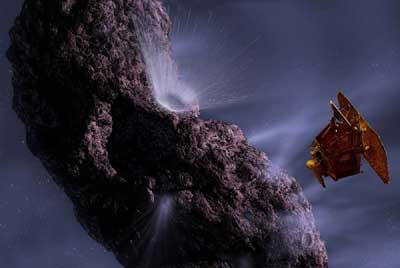NASA officials hope that they will be able to evaporate the moisture that has accumulated on the camera lens before the spacecraft arrives in July at comet Temple 1 and crashes a small rocket on its surface
Avi Blizovsky

Direct link to this page: https://www.hayadan.org.il/deep0305.html
The Deep Impact spacecraft has completed the qualification phase of the mission. Mission controllers have confirmed that all spacecraft instruments are working as planned. It has now entered the cruise phase, which will now last up to 60 days before impact with comet Temple-1 on July 4, 2005. The spacecraft itself contains four data collectors that will watch as the impactor spacecraft crashes into the comet, creating a stadium-sized hole and providing astronomers with the best images of Comets received so far.
The testing and certification phase began immediately after the launch of the spacecraft, on January 12, 2005. The spacecraft's independent navigation systems were activated and tested using the Moon and Jupiter as targets. The spacecraft's powerful antenna that will transmit the data from the crash on the comet has been activated and is working well. A course correction was made, and the spacecraft's flight path to comet Temple-1 is still there. The maneuver was so successful that a second maneuver planned for March 31 was canceled.
Another event during the testing phase was the heating of the high resolution cameras to remove moisture that had accumulated on the camera's cylinder during the spacecraft's long stay on the launch pad. After the evaporation process, test shots were taken. The photos were the update that the telescope did not reach the optimal focus. A special team was formed to investigate the telescope's performance and planned activities designed to bring the telescope into good focus until reaching its destination. Future calibration tests will provide more information about the device's performance.
As mentioned, the spacecraft has four devices: a high-resolution camera, an infrared spectrometer that includes a high-resolution device, a medium-resolution camera, and another camera placed on the impactor as a target sensor. They will record the last moments of the vehicle before it crashes into the comet at a speed of about 37 km/h. The medium resolution camera and the camera on the smash missile work as intended.
The spacecraft site
For information on the NASA website
They knew the asteroids and comets
https://www.hayadan.org.il/BuildaGate4/general2/data_card.php?Cat=~~~120449947~~~18&SiteName=hayadan
